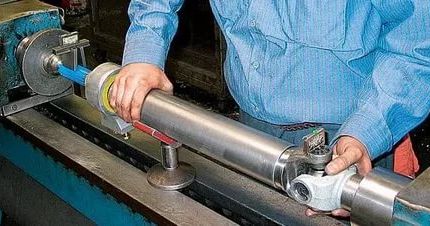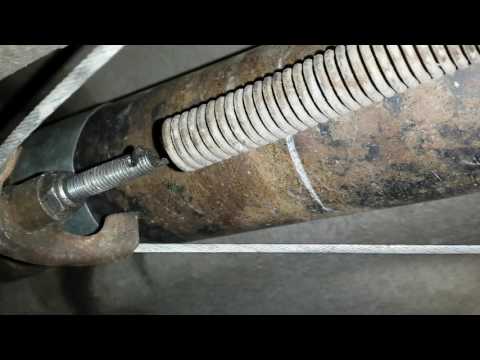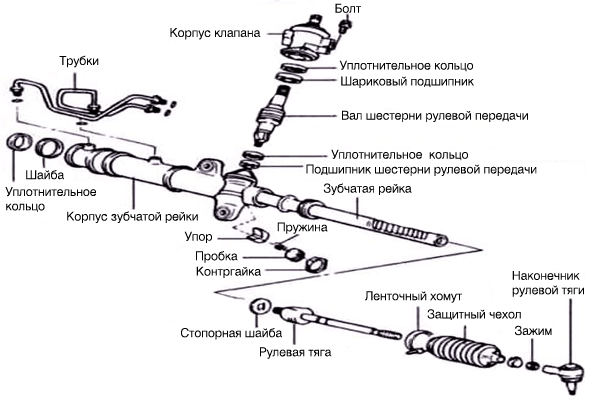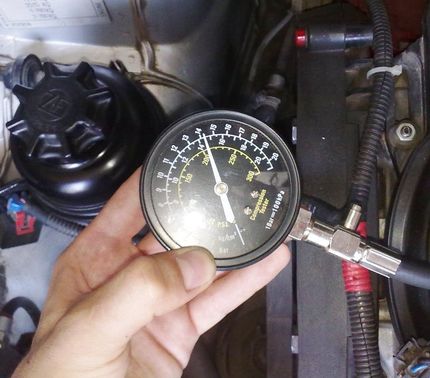
Balancing the propeller shaft
Content
Balancing the cardan shaft can be done both with your own hands and at the service station. In the first case, this requires the use of special tools and materials - weights and clamps. However, it is better to entrust the balancing of the “cardan” to the workers of the service station, since it is impossible to manually calculate the mass of the balancer and the place of its installation with accuracy. There are several “folk” balancing methods, which we will talk about later.
Signs and causes of imbalance
The main sign of the occurrence of an imbalance in the cardan shaft of a car is appearance of vibration the entire body of the vehicle. At the same time, it increases as the speed of movement increases, and, depending on the degree of imbalance, it can manifest itself both already at a speed of 60-70 km / h, and more than 100 kilometers per hour. This is a consequence of the fact that when the shaft rotates, its center of gravity shifts, and the resulting centrifugal force, as it were, “throws” the car on the road. An additional sign in addition to vibration is the appearance characteristic humemanating from under the bottom of the car.
Neglect of breakdown can lead to such consequences.
There are several reasons for this breakdown. Among them:
- natural wear and tear parts for long-term operation;
- mechanical deformationscaused by impacts or excessive loads;
- manufacturing defects;
- large gaps between the individual elements of the shaft (in case it is not solid).
Regardless of the reasons, when the symptoms described above appear, it is necessary to check for imbalance. Repair work can be done in your own garage.
How to balance the gimbal at home
Let's describe the process of balancing the cardan shaft with our own hands using the well-known "grandfather" method. It is not difficult, but it can take quite a while to complete. a lot of time. You will definitely need a viewing hole, on which you must first drive the car. you will also need several weights of different weights used in wheel balancing. Alternatively, instead of weights, you can use electrodes cut into pieces from welding.
Primitive weight for balancing the cardan at home
The algorithm of work will be as follows:
- The length of the cardan shaft is conditionally divided into 4 equal parts in the transverse plane (there may be more parts, it all depends on the amplitude of the vibrations and the desire of the car owner to spend a lot of time and effort on this).
- To the surface of the first part of the cardan shaft securely, but with the possibility of further dismantling, attach the aforementioned weight. To do this, you can use a metal clamp, plastic tie, tape or other similar device. Instead of a weight, you can use electrodes, which can be placed under the clamp several pieces at once. As the mass decreases, their number is reduced (or vice versa, with an increase, they are added).
- further testing is carried out. To do this, they drive the car on a flat road and analyze whether the vibration has decreased.
- If nothing has changed, you need to return to the garage and transfer the load to the next segment of the cardan shaft. Then repeat testing.
Mounting the gimbal weight
Items 2, 3 and 4 from the above list must be performed until you find a section on the carriage shaft where the weight reduces vibration. further, similarly empirically, it is necessary to determine the mass of the weight. Ideally, with its correct selection vibration should be gone. at all.
The final balancing of the “cardan” with your own hands consists in rigidly fixing the selected weight. For this, it is desirable to use electric welding. If you don’t have it, then in extreme cases you can use a popular tool called “cold welding”, or tighten it well with a metal clamp (for example, plumbing).

Balancing the cardan shaft at home
There is also one, albeit less effective, method of diagnosis. According to it, you need dismantle this shaft from the car. After that, you need to find or pick up a flat surface (preferably perfectly horizontal). Two steel corners or channels are placed on it (their size is unimportant) at a distance slightly less than the length of the cardan shaft.
After that, the "cardan" itself is laid on them. If it is bent or deformed, then its center of gravity is also cm. Accordingly, in this case, it will scroll and become so that its heavier part will be at the bottom. This will be a clear indication to the car owner in which plane to look for imbalance. Further steps are similar to the previous method. That is, weights are attached to this shaft and the places of their attachment and mass are experimentally calculated. Naturally, the weights are attached on the opposite side from the one where the center of gravity of the shaft is also referred to.
also one effective method is to use a frequency analyzer. It can be made by hand. However, a program is needed that imitates an electronic oscilloscope on a PC, showing the level of the frequency of oscillations that occur during the rotation of the gimbal. You can say it from the Internet in the public domain.
So, to measure sound vibrations, you need a sensitive microphone in mechanical protection (foam rubber). If it is not there, then you can make a device from a speaker of medium diameter and a metal rod that will transmit sound vibrations (waves) to it. To do this, a nut is welded into the center of the speaker, into which a metal rod is inserted. A wire with a plug is soldered to the speaker outputs, which is connected to the microphone input in the PC.
Further, the measurement procedure occurs according to the following algorithm:
- The drive axle of the car is hung out, allowing the wheels to rotate freely.
- The driver of the car "accelerates" it to a speed at which vibration usually appears (usually 60 ... 80 km / h, and gives a signal to the person who takes the measurements.
- If you are using a sensitive microphone, then bring it close enough to the place of marking. If you have a speaker with a metal probe, then you must first fix it to a place as close as possible to the applied marks. The result is fixed.
- Conditional four marks are applied to the carat shaft around the circumference, every 90 degrees, and they are numbered.
- A test weight (weighing 10 ... 30 grams) is attached to one of the marks using a tape or clamp. it is also possible to use the bolted connection of the clamp as a weight.
- further measurements are taken with a weight at each of the four places in sequence with numbering. That is, four measurements with the transfer of cargo. The results of the oscillation amplitude are recorded on paper or computer.
Location of imbalance
The result of the experiments will be the numerical values of the voltage on the oscilloscope, which differ from each other in magnitude. then you need to build a scheme on a conditional scale that would correspond to numerical values. A circle is drawn with four directions corresponding to the location of the load. From the center along these axes, segments are plotted on a conditional scale according to the data obtained. Then you should graphically divide segments 1-3 and 2-4 in half by segments perpendicular to them. A ray is drawn from the middle of the circle through the intersection point of the last segments to the intersection with the circle. This will be the unbalance location point that needs to be compensated (see figure).
The desired point for the location of the compensation weight will be at the diametrically opposite end. As for the mass of the weight, it is calculated by the formula:
where:
- unbalance mass - the desired value of the mass of the established imbalance;
- vibration level without test weight — the voltage value on the oscilloscope, measured before installing the test weight on the gimbal;
- average value of the vibration level - the arithmetic average between four voltage measurements on the oscilloscope when installing a test load at four indicated points on the gimbal;
- weight value of the test load - the value of the mass of the established experimental load, in grams;
- 1,1 - correction factor.
Usually, the mass of the established imbalance is 10 ... 30 grams. If for some reason you did not manage to accurately calculate the imbalance mass, you can set it experimentally. The main thing is to know the installation location, and adjust the mass value during the ride.
However, as practice shows, self-balancing the driveshaft using the method described above only partially eliminates the problem. It will also be possible to drive the car for a long time without significant vibrations. But it will not be possible to completely get rid of it. Therefore, other parts of the transmission and chassis will work with it. And this negatively affects their performance and resource. Therefore, even after self-balancing, you need to contact the service station with this problem.
Technological repair method
Cardan Balancing Machine
But if for such a case you don’t feel sorry for 5 thousand rubles, this is exactly the price of balancing the shaft in the workshop, then we recommend going to the specialists. Performing diagnostics in repair shops involves the use of a special stand for dynamic balancing. To do this, this shaft is dismantled from the car and installed on it. The device includes several sensors and so-called control surfaces. If the shaft is unbalanced, then during rotation it will touch the mentioned elements with its surface. This is how the geometry and its curvature are analyzed. All information is displayed on the monitor.
Repair work can be carried out in various ways:
- Installation of balancer plates precisely on the surface of the cardan shaft. At the same time, their weight and installation location are accurately calculated by a computer program. And they are fastened with the help of factory welding.
- Balancing the cardan shaft on a lathe. This method is used in case of significant damage to the geometry of the element. Indeed, in this case, it is often necessary to remove a certain layer of metal, which inevitably leads to a decrease in the strength of the shaft and an increase in the load on it in normal operation modes.
It will not be possible to produce such a machine for balancing cardan shafts with your own hands, since it is very complicated. However, without its use, it will not be possible to produce high-quality and reliable balancing.
Results
It is quite possible to balance the cardan yourself at home. However, you need to understand that it is impossible to choose the ideal mass of the counterweight and the place of its installation on your own. Therefore, self-repair is possible only in case of minor vibrations or as a temporary method of getting rid of them. Ideally, you need to go to a service station, where they will balance the cardan on a special machine.

